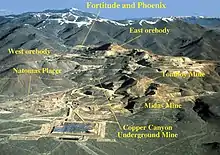Battle Mountains, Nevada
The Battle Mountains or Battle Mountain Range[4] is a mountain range in western Lander and southeastern Humboldt counties of Nevada. The communities of Battle Mountain and Valmy lie just to the east and north respectively along Interstate 80 in the Humboldt River valley. Nevada State Route 305 runs along the southeast side of the range from Battle Mountain toward Austin to the south.[5]
| Battle Mountains, Nevada | |
|---|---|
 Battle Mountains in Nevada | |
| Highest point | |
| Peak | North Peak, Humboldt County |
| Elevation | 2,606 m (8,550 ft) |
| Coordinates | 40°40′30″N 117°07′57″W[1] |
| Dimensions | |
| Length | 24 km (15 mi) N-S |
| Width | 22 km (14 mi) E-W |
| Area | 337 km2 (130 sq mi)[2] |
| Geography | |
| Country | United States |
| State | Nevada |
| Range coordinates | 40°37′2″N 117°7′12″W[3] -- |
| Borders on | Fish Creek Range SW and Shoshone Range SE |
| Topo map | USGS Antler Peak, Galena Canyon, North Peak, and Snow Gulch, Nevada 7.5 Minute Quads |
The range is roughly circular in shape and exhibits radial drainage. The Humboldt River Valley lies to the northeast with the Sheep Creek Range beyond. To the northwest and west is Buffalo Valley with Buffalo Mountain and the Tobin Range beyond. The Fish Creek Range lies to the southwest and the Reese River Valley and Shoshone Range to the southeast.[5]
Peaks
Named peaks include:
| Peak | Peak elevation[5] | Coordinates[6] |
| North Peak | 8,550 ft (2,610 m) | 40° 40′ 31″ N 117° 08′ 00″ W |
| Antler Peak | 8,236 ft (2,510 m) | 40° 35′ 57″ N 117° 08′ 03″ W |
| Long Peak | 7,870 ft (2,400 m) | 40° 37′ 08″ N 117° 06′ 08″ W |
| Chessor Mountain | 6,018 ft (1,834 m) | 40° 31′ 59″ N 117° 06′ 09″ W |
| Elephant Head | 5,930 ft (1,810 m) | 40° 36′ 42″ N 117° 01′ 09″ W |
Mining in the Battle Mountains

The range has a long history of mining following the original discovery in 1866. The earliest mining was around the old mining camp of Copper Basin in Long Canyon which lies 5.4 miles (8.7 km) west of the current town of Battle Mountain. The Copper Basin area was the original location of the Battle Mountain mining camp which later moved to the current location on the Humboldt as a mining support town. To the southwest about 4.2 miles (6.8 km) in Galena Canyon, the mining camps of Bannock, Copper Canyon and Galena were later developed with the Bannock camp established in 1909. The area produced copper, gold, silver, antimony, lead, zinc, tungsten, molybdenum, arsenic, turquoise, and nickel.[7] The Marigold Gold mine is located in the north end of the range.[8]
References
- North Peak, Nevada, 7.5 Minute Topographic Quadrangle, USGS, 1984
- Measurements from Winnemucca, Nevada 30x60 USGS Quad (approximately the 1750 meter contour on west side and 1500 m contour east side (break in slope))
- Winnemucca, Nevada, 30x60 Minute Topographic Quadrangle, USGS, 1986
- GNIS: Battle Mountain
- Nevada Atlas and Gazetteer (8th ed.). DeLorme. 2012. pp. 29–30, 37–38. ISBN 978-0-89933-334-2.
- Coordinates from GNIS search for each peak
- Joseph V. Tingley, Mining Districts of Nevada, Nevada Bureau of Mines and Geology, Report 47, 2nd ed., 1998, pp. 27-28 Archived 2015-02-21 at the Wayback Machine
- Infomine: Marigold